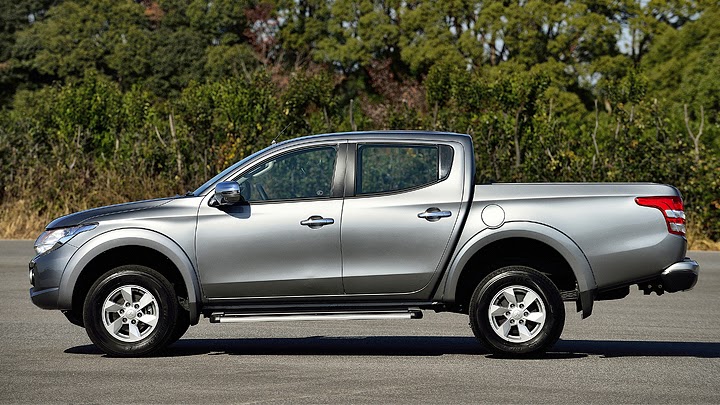
Do you remember what Honda and Toyota say about Civic and Corolla’s updates? These sedans’ new generations alternate between a complete change and just an evolution of the previous car – the first kind comes at odd times for the first car and at even times for the second. Judging by this article’s pictures, it seems that Mitsubishi adopted the same strategy for its pick-up. The fourth L200 followed the new approach Toyota Hilux brought to the category, and featured several improvements focused on urban use, not to mention the complete design change. Nine years later, it seems like the Japanese didn’t want to take risks. Since people already liked the previous car, and the competition is getting harder every year, this time the decision went towards discretion.
The previous dynamic feeling was toned down in favor of more regular lines, probably in order to increase internal space. The front fascia highlights the imponent set created by a big chrome grille and irregularly-shaped headlights, although they’re not exactly award-winning – combining rectangular grille with round fog lights doesn’t make the lower portion better. The sides resemble GR-HEV much less than one would expect, but since this is a car which changes once a decade, avoiding extravagances is the best way to keep customers satisfied. The rear part, as usual, features simple lines so as to optimize bed capacity. The new pick-up will be sold in regular and crew cabs, under the names of L200, Triton and several others used in fewer countries.







Opening the doors will remind of the latest goals Mitsubishi decided to pursue: the Jetfighter-design sportiness was dropped in favor of comfort, fuel efficiency and space for entire families at reasonable prices. The dashboard looks quite good despite being as simple as it can possibly be: there are two-tone coating, piano-black zones and chrome inserts, but everything designed in a way that makes most of L200’s competitors seem frivolous. The equipment list follows those cars with items such as infotainment central and some electronic safety systems, but Mitsubishi also claims to have performed technical improvements: compared to the previous model, soundproofing and suspension were reworked in order to reduce NVH levels.
Mitsubishi will offer four engines for the new pick-up. The only gasoline-burner is a 2.4-liter, good for 128 hp and 19.8 kgfm. Switching to diesel, the turbocharged 2.5-liter received some tweaks and now comes as follows: 128 hp and 24.5 kgfm, or 178 cv and 40.8 kgfm. But the biggest star is the brand new MIVEC 2.4-liter, which is capable of 181 hp and 43.8 kgfm. When it comes to gearboxes, there are five or six-speed manual and five-speed automatic. Always produced exclusively in the Thai plant of Laem Chabang (other countries only assemble CKD kits), the all-new L200 is expected to reach 150 countries, between Africa, Europe, Latin America, Middle East, Oceania and Southeast Asia.